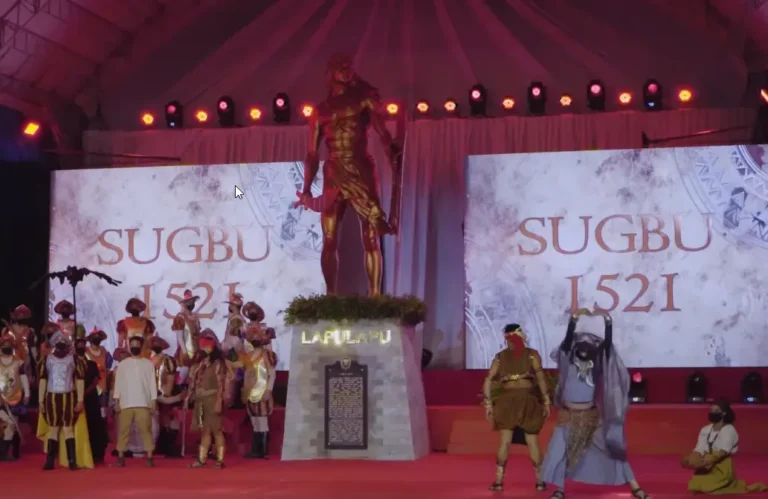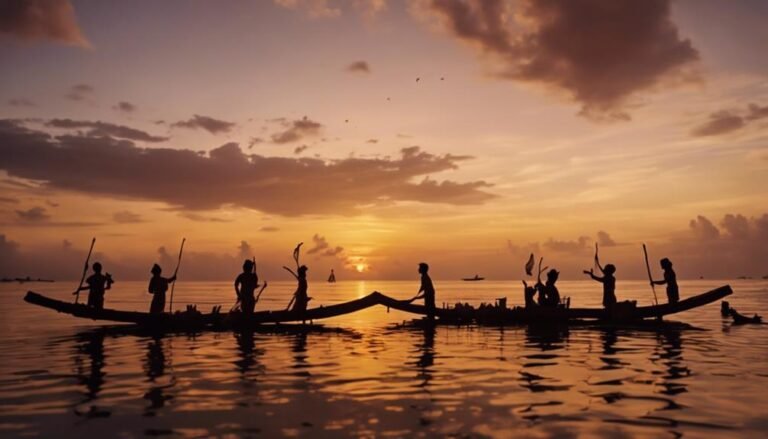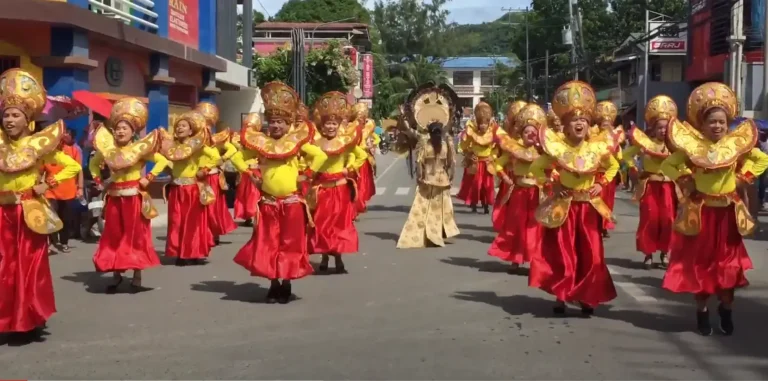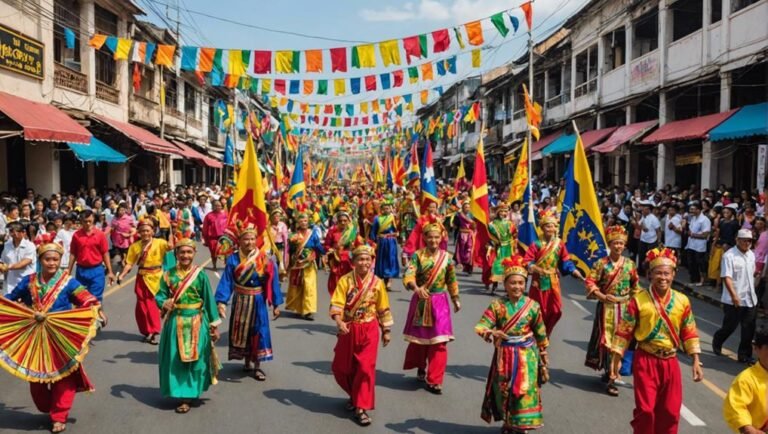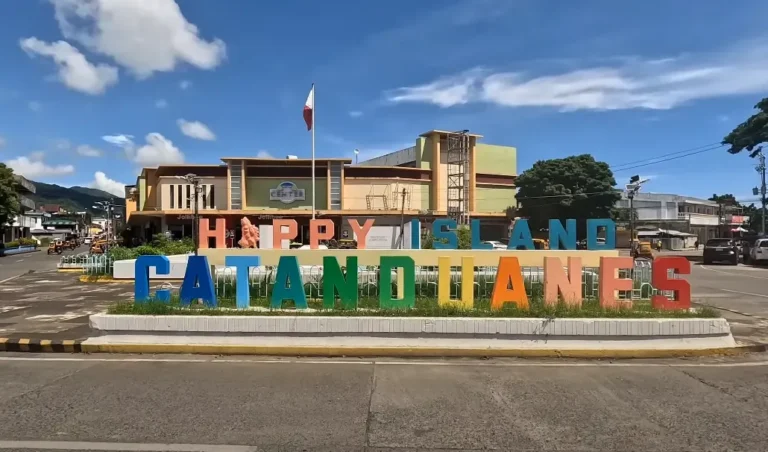Bayluhay Festival Philippines

The Bayluhay Festival is a cultural celebration that showcases the rich heritage and traditions of the Philippines.
It is a vibrant event that brings together local communities to honor and preserve their cultural roots.
Through colorful parades, traditional dances, music, and costumes, the festival highlights the historical significance of the Bayluhay epic.
All of which tells the story of the migration of the ten Bornean Datus to Panay Island. The festival aims to promote unity, pride, and appreciation for the country’s cultural diversity, making it a must-see event for both locals and tourists alike.
Key Takeaways
- The Bayluhay Festival celebrates the historic Barter of Panay and is held annually in January.
- The festival includes activities such as folk-cultural tribal dance competitions, entertainment, cultural shows, and a parade.
- The culminating event of the festival is Pasungay, where bulls fight in the arena, attracting a large crowd of spectators.
- The festival also features the prestigious beauty pageant called the Search for Dayang Kang Bayluhay, showcasing the beauty and talent of the contestants.
Facts About The Bayluhay Festival
| Facts | Explanation |
|---|---|
| Name of the Festival | Bayluhay Festival |
| Type of Festival | Cultural Festival |
| City of Origin | Bago City, Negros Occidental, Philippines |
| Festival Etymology | The word “Bayluhay” is derived from the Hiligaynon term “baylo” which means change, and “hayahay” which means relaxed or comfortable. |
| First Celebration | December 21, 1981 |
| Festival Founder | Honorable Manuel Y. Torres |
| Festival History | The Bayluhay Festival was established to celebrate the rich cultural heritage of Bago City and its people. It showcases various traditional dances, music, arts, and crafts of the local community. Over the years, the festival has grown to become a significant event promoting unity, pride, and cultural preservation. |
| City History | Bago City is a thriving city located in the province of Negros Occidental, Philippines. It has a rich history that dates back to the Spanish colonial era. The city played a vital role in the sugar industry and served as a hub for trade and commerce. Today, Bago City is known for its vibrant culture and warm hospitality. |
| Ethnic Information | The majority of the population in Bago City belongs to the Hiligaynon ethnic group. |
| City Location | Bago City is located in the province of Negros Occidental, which is part of the Western Visayas region in the Philippines. |
| How to Reach | Bago City can be reached by taking a domestic flight to Bacolod-Silay Airport, followed by a land journey to Bago City. Alternatively, one can take a bus or private vehicle from neighboring cities like Bacolod or Iloilo. |
| Nearby Cities | – Bacolod City: 21 km – Iloilo City: 83 km |
| Google Map Link | Bago City Location |
| Main Events | – Street Dancing Parade – Cultural Presentations – Traditional Music and Dance Performances – Food and Crafts Fair |
| Famous Tourist Attractions | – Manuel Y. Torres Ancestral House: A heritage house showcasing the rich history and lifestyle of Bago City. – Mag-aso Falls: A stunning waterfall surrounded by lush greenery and natural beauty. |
| Famous Food Dishes | – Chicken Inasal: Grilled chicken marinated in a special sauce, popular in Bacolod and surrounding areas. – Piaya: A sweet delicacy made of flatbread filled with muscovado sugar, a favorite local treat. |
| Landmarks | – Bantayan Park: A picturesque park with a lagoon, gardens, and recreational facilities. – San Sebastian Cathedral: A beautiful church known for its Spanish colonial architecture. |
| Related Festivals | – Panaad sa Negros Festival: A grand celebration held in Bacolod City, showcasing the culture and heritage of Negros Occidental. – MassKara Festival: An internationally recognized festival in Bacolod City, known for its colorful masks and vibrant street performances. |
Brief History of The Festival & City
The Bayluhay Festival is a cultural celebration held in the city of Bago, Negros Occidental, Philippines. It is a week-long event that showcases the rich heritage and traditions of the people of Bago.
The festival is named after the Bayluhay, which is a Visayan term meaning “to unite” or “to make a pact.” It commemorates the arrival of the ten Bornean Datus (chieftains) in Panay Island in the 13th century. These Datus escaped the tyrannical rule of Sultan Makatunaw and sought refuge in the Visayas region.
They made a pact of friendship with the indigenous Ati people, which led to the establishment of the first Malay settlement in the Philippines.
The Bayluhay Festival aims to promote unity and cultural diversity among the people of Bago. It features various activities such as street dancing, parades, traditional games, beauty pageants, and food fairs.
Participants wear colorful costumes and perform traditional dances to showcase the unique cultural heritage of the city.
The festival also highlights the agricultural abundance of Bago, known as the “Rice Granary of Negros.” Visitors can experience the local cuisine, arts and crafts, and agricultural products during the festival.
Over the years, the Bayluhay Festival has become a significant event in Bago City, attracting both locals and tourists from different parts of the country. It not only serves as a platform to preserve and promote cultural traditions but also boosts tourism and economic activities in the city.
What Type of Festival is This
San Joaquin, Iloilo is known for its unique mixture of races and cultures, reflecting the diverse ethnic background of its inhabitants.
The festival’s name itself, “Bayluhay,” is derived from the Hiligaynon word “baylo” or “exchange,” symbolizing the exchange of cultures and customs that have shaped the town’s identity.
The Bayluhay Festival showcases a blend of indigenous rituals and influences from later Spanish traditions. These elements come together in a magnificent display that pays homage to the area’s rich history and ethnicity.
Observers can witness performances and activities that celebrate the fusion of these cultural influences, making the festival a testament to the Filipino spirit of preserving their ethnic heritage.
Not only does the Bayluhay Festival offer an opportunity to celebrate local culture and history, but it also serves as a time for community togetherness and gratitude, as it honors the ancestors and their enduring legacy in San Joaquin.
For those looking to experience a part of the Philippines’ rich ethnicity, the Bayluhay Festival is an excellent occasion to be amazed at how Filipinos cherish and maintain their cultural practices amidst modernization. It is a lively, colorful, and meaningful celebration that captures the heart of Iloilo’s ethnically diverse society.
Ethnic Information Of The City & Region
The city of San Joaquin in the Philippines is known for its diverse ethnic communities, including the Ati, Hiligaynon, and Kinaray-a groups.
These communities contribute to the vibrant cultural tapestry of the region. The Ati people, who are indigenous to the Visayas, have played a significant role in shaping the area’s history.
Centuries ago, their interaction with Bornean Datus resulted in a cultural fusion that is celebrated at the Bayluhay Festival.
This historic encounter, which involved the exchange of land for goods, represents the peaceful assimilation of different cultures and remains an important part of San Joaquin’s heritage. Understanding these ethnic dynamics provides insight into the essence of San Joaquin and its lively festivals.
Festival Etymology
The festival’s name “Bayluhay” is derived from the Hiligaynon word “baluhay,” which means “to gather” or “to unite.” This name reflects the spirit of unity and collective effort in preserving and promoting the town’s cultural identity.
During the festival, locals and visitors alike participate in various activities such as street dancing, parades, cultural performances, and traditional games.
The Bayluhay Festival serves as a platform to honor the town’s ancestors, strengthen community bonds, and promote tourism in the area.
The History and Significance Of The City & Festival
The Bayluhay Festival is an annual celebration held in the city of Bago, Negros Occidental, Philippines. It is a historical and cultural event that showcases the rich history and heritage of the city.
The festival traces its roots back to the pre-colonial era when the early settlers, known as the Negritos, lived in the area. Bayluhay is a Hiligaynon term which means “to move forward” or “to progress.” The festival aims to commemorate the migration and progress of the early settlers as well as to promote unity and cultural pride among the locals.
During the festival, various activities and events are held, including street dances, parades, beauty pageants, sports competitions, and cultural shows. These activities highlight the traditional music, dance, costumes, and customs of the Negrenses.
The Bayluhay Festival also serves as an avenue to promote tourism in Bago City. Visitors from different parts of the Philippines and even from other countries come to witness the festivities and experience the vibrant culture and warm hospitality of the locals.
The festival holds great significance for the people of Bago as it not only celebrates their history but also serves as a reminder of their resilience and determination to progress. It is a time for the community to come together, strengthen their bonds, and showcase their unique heritage to the world.
Location of the City In The Country
San Joaquin is nestled in the southwestern part of Iloilo province, on the island of Panay in the Philippines.
This quaint town is not just a hub for cultural festivities but also a gateway to some of Iloilo’s historical treasures and natural wonders. To help you visualize the location and significance of San Joaquin within Iloilo, here’s a table that breaks down key points:
| Aspect | Description |
|---|---|
| Region | Western Visayas |
| Island | Panay |
| Province | Iloilo |
| Municipality | San Joaquin |
| Festival Significance | Celebrates pre-Hispanic history & culture |
Location on Map
How to Reach The City
To reach the city of San Joaquin, you have a few options depending on your starting point and preferred mode of transportation:
- By Air: The nearest major airport to San Joaquin is the Fresno Yosemite International Airport (FAT), located approximately 57 miles northwest of the city. From the airport, you can rent a car or take a taxi to reach San Joaquin.
- By Car: If you are driving from within California, you can reach San Joaquin via Interstate 5 (I-5) or State Route 99 (SR 99). These highways provide direct access to the city from various directions.
- By Bus: Several bus services operate in the area, including Greyhound and Amtrak Thruway buses. You can check their schedules and routes to find the most convenient option for reaching San Joaquin.
- By Train: Although San Joaquin does not have a train station, you can take an Amtrak train to nearby cities such as Fresno or Bakersfield, and then use other transportation methods to reach San Joaquin.
Remember to plan your journey in advance and consider factors such as distance, travel time, and transportation availability to ensure a smooth trip to the city of San Joaquin.
| Mode of Transportation | Traveling Time | Fare Range |
|---|---|---|
| Car | 30 minutes | $5 – $10 |
| Bus | 45 minutes | $2 – $5 |
| Train | 1 hour | $3 – $8 |
| Taxi | 25 minutes | $10 – $20 |
Please note that the traveling time and fare range mentioned above are approximate values and may vary depending on traffic conditions and other factors.
Nearby Cities or Towns & Their Distance
Once you’ve arrived in San Joaquin, you’ll find it’s conveniently surrounded by several towns and cities, each offering their unique charm and just a short trip away.
If you’re eager to explore more of Panay Island, you’ll be delighted to know that these nearby places are easily accessible and well worth the visit.
You can immerse yourself in local culture by visiting different barangays, each with its distinct attractions and activities.
Here’s a quick guide to help you plan your trips:
| Town/City | Distance from San Joaquin |
|---|---|
| Iloilo City | 53 km |
| Miagao | 19 km |
| Guimbal | 13 km |
Festival main events and activities
While you’re exploring the nearby towns of San Joaquin, don’t miss the Bayluhay Festival’s main events, which include the vibrant folk-cultural tribal dance competition and the exhilarating Pasungay bullfights.
Sharing a similar theme with the Dinagyang Festival and rooted in the Feast of San Joaquin, the Bayluhay Festival offers an array of activities:
Folk-Cultural Tribal Dance Competition
- Showcases the rich heritage and colorful history of the region.
- Competing groups tell stories through movement and music.
Pasungay Bullfights
- A thrilling display of raw power as bulls lock horns.
- Draws spectators from all over, adding to the festival’s fervor.
- Maaram: This involves the participation of individuals known as maaram who engage in folk healing. They are believed to be the bearers of ancient medicinal practices passed down through generations.
- Dinapay: A captivating war dance that also serves as a rite of passage. The Dinapay is historically significant as it is said to be one of the first performances enacted during the Barter of Panay.
Popular Food Dishes of The City
As you indulge in the Bayluhay Festival’s celebrations, don’t miss out on the city’s renowned culinary delights. The Philippine festival is not just about the vibrant traditional costumes and dances; it’s also a feast for the taste buds!
Local Favorites:
- Chicken Inasal: Barbecued chicken marinated in a mixture of Calamansi, pepper, and vinegar.
- Batchoy: A noodle soup made with pork organs, crushed pork cracklings, chicken stock, and beef loin.
Sweet Treats:
- Piaya: A muscovado-filled unleavened flatbread that’s a perfect snack.
- Barquillos: Thin, rolled wafers that are a delightful crunchy treat.
| Dish | Main Ingredients | Description |
|---|---|---|
| Chicken Inasal | Chicken, Calamansi, lemongrass | Marinated and grilled to perfection |
| Batchoy | Noodles, pork organs | Rich soup with a hearty flavor |
| Piaya | Muscovado sugar, flour | Sweet, chewy filling in a flatbread |
| Barquillos | Flour, milk, sugar | Crispy rolled wafers |
| KBL | Pork, black beans, jackfruit | A savory stew known locally |
Tips for attending The Festival
Before setting out for the Bayluhay Festival, you’ll need to pack smartly to navigate the festivities with ease.
- Bring comfortable clothing suitable for tropical weather and a pair of sturdy shoes, as you’ll be on your feet, dancing and exploring.
- Don’t forget to apply sunscreen and stay hydrated throughout the day.
- Carry a light backpack for essentials like a water bottle, a camera, and a portable charger, these will come in handy for capturing memories without running out of juice.
Famous Tourist Spots in the City
The city of San Joaquin, located in the Philippines, is known for its beautiful tourist spots. Here are some famous tourist spots in San Joaquin:
- San Joaquin Church (Santo Tomas de Villanueva Parish Church): This stunning Baroque-style church is a National Cultural Treasure. It features intricate carvings and a unique facade that depicts the Battle of Tetuan.
- San Joaquin Cemetery: Also known as the Campo Santo, this cemetery is famous for its elaborate Spanish-era burial grounds. The cemetery features a grand staircase leading to a chapel and offers a picturesque view of the sea.
- Marbuena Island: This small island off the coast of San Joaquin is a popular destination for beach lovers. It boasts crystal-clear waters, white sand beaches, and vibrant marine life, making it a perfect spot for snorkeling and diving.
- Iloilo Golf and Country Club: Located in San Joaquin, this golf course offers stunning views of the surrounding mountains and coastline. Golf enthusiasts can enjoy playing on its well-maintained fairways and greens.
- Garin Farm Pilgrimage Resort: Situated in San Joaquin, this unique resort combines leisure and spirituality. It features a replica of the Holy Land, a 456-step stairway to heaven, and a meditation garden. Visitors can also enjoy farm activities and experience rural life.
These are just a few of the famous tourist spots in the city of San Joaquin. Exploring these attractions will give you a glimpse of the rich cultural heritage and natural beauty of the area.
| Tourist Spot | Experience |
|---|---|
| Garín Farm | Spiritual rejuvenation |
| San Joaquin Church | Architectural awe |
| San Joaquin Cemetery | Historical reflection |
| Miagao Fortress Church | UNESCO World Heritage admiration |
Venture into these sites to enrich your understanding of the local culture and history.
Famous Landmarks in the city
You’ll find that each landmark in San Joaquin tells a unique story of the city’s rich history and cultural heritage.
- San Joaquin Iloilo Lighthouse: Also known as Faro de Punta de Salto, this lighthouse is situated on a hill overlooking the sea. It was built in 1892 during the Spanish colonial period and offers stunning views of the surrounding area.
- Garin Farm Pilgrimage Resort: This unique attraction combines religious elements with leisure activities. Visitors can climb a 456-step staircase adorned with life-sized statues depicting the journey of Jesus Christ. At the top, there is a beautiful chapel and a panoramic view of the farm.
- Balaan Bukid Shrine: Located in the nearby municipality of Guimbal, this shrine is perched on top of a hill and offers a peaceful retreat for prayer and reflection. It features a life-sized statue of the crucified Christ and provides a stunning view of the Guimbal coastline.
Related Festivals in the Same Region
Some of the main Festivals include,
| Festival | Location | Main Attraction |
|---|---|---|
| Ati-Atihan | Kalibo, Aklan | Street dancing, costumes |
| Dinagyang | Iloilo City | Dance competition, food |
| Bayluhay | San Joaquin | Historical reenactments |
| Paraw Regatta | Iloilo City | Sailboat racing |
| MassKara | Bacolod City | Masks, street parties |
Summary Of Bayluhay Festival in San Joaquin
| Category | Information |
|---|---|
| Name | Bayluhay Festival |
| Celebration | Cultural and historical festival |
| Location | San Joaquin, Iloilo, Philippines |
| Date | Third week of January |
| Duration | 1 week |
| Historical Facts | – Celebrates the historic founding of San Joaquin in the 13th century with the coming of the Malays – Based on the legend of the Barter of Panay, where ten Shri-Vijayan Datus and their retinue settled in Panay after fleeing from Borneo |
| Festival Activities | – Folk-cultural tribal dance competition showcasing historical depictions – Beauty Pageant. Search for Dayang kang Bayluhay (also known as Fiesta Queen) – Pasungay, a popular event featuring bullfights – Rituals and performances related to folk healing and a war dance called dinapay |
| Transportation | – Reach Iloilo International Airport by plane, then take a bus to the city terminal – From the city terminal, take a ride to Antique and stop at the town of San Joaquin |
How Does the Bayluhay Festival Differ from the Bambanti Festival in the Philippines?
The Bayluhay Festival celebrates the rich cultural heritage and history of the municipality of Bayombong. It showcases the traditional Bambanti Festival which focuses on the role of scarecrows in the lives of the farmers. The Bambanti Festival, on the other hand, highlights the importance of agriculture and the impact of farmers in the community.
What are the similarities and differences between the Bayluhay Festival and the Buyogan Festival?
The Bayluhay Festival and Buyogan Festival are both vibrant leyte philippines celebrations that showcase the rich cultural heritage of the region. While Bayluhay focuses on the reenactment of the first Filipino Mass, Buyogan is a lively street dance competition featuring colorful bee-inspired costumes. Both festivals are must-see events in Leyte.
Final Thoughts
The Bayluhay Festival in San Joaquin, Philippines, celebrates the region’s cultural heritage through traditional dances, music, and parades.
It commemorates the Barter of Panay and the arrival of the ten Bornean Datus. This vibrant event promotes unity, and pride, and showcases the city’s historical landmarks and natural beauty.
With a blend of indigenous rituals and Spanish influences, the festival offers a glimpse into the diverse ethnic tapestry of the region.
Visitors can enjoy local delicacies and explore famous tourist spots like San Joaquin Church and Marbuena Island. The Bayluhay Festival is a must-see event to experience the rich cultural heritage of the Philippines.
Frequently Asked Questions
Are There Any Community Service or Environmental Initiatives Tied to the Bayluhay Festival to Promote Sustainability?
You’re likely wondering about sustainable efforts in local festivals. While details are scarce, some festivals do incorporate clean-ups or “green” practices to promote environmental stewardship alongside cultural celebration.
How Does the Bayluhay Festival Impact the Local Economy and Small Businesses Within San Joaquin?
The festival boosts the local economy by increasing tourism, which benefits small businesses in San Joaquin through heightened sales of food, crafts, and services during the celebratory period.
What Accommodations Are Available for Individuals With Disabilities Who Wish to Attend the Bayluhay Festival?
You’ll find accessible accommodations for disabled attendees, including ramps and special seating areas, ensuring everyone can enjoy the festivities comfortably and safely. Assistance is also typically available upon request.
Can International Tourists Participate in Any of the Festival Activities, and if So, Are There Specific Ones Designed for Them?
You can certainly join in the festival’s activities! There are no specific events for international guests, but you’re welcome to enjoy the cultural shows, parades, and the tribal dance competition alongside locals.
Are There Educational Programs or Workshops Offered During the Bayluhay Festival to Teach Attendees About the Historical and Cultural Significance of the Barter of Panay?
You’ll find workshops and programs at the festival that delve into the Barter of Panay’s history and culture, enhancing your understanding and appreciation of this pivotal event.

